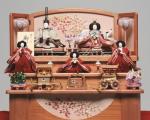Landscape panel made from pieces of torn paper. Making fun paper applications with your kids
It allows you to develop skills in handling scissors, improve the work of children's hands and make the baby more careful. Every child will be able to make appliqués from colored paper with their own hands if they are given a feasible task.
So, the most affordable options for colored paper applique for children 4-5 years old can be:

Volumetric applications made of colored paper
Ladybugs. Cut out two red circles and a black semi-oval. Black dots are placed on the circles, after which one circle is glued exactly above the black semi-oval, and the second is bent in half and glued to the first circle. We complement the bug with toy eyes and antennae.

Materials for the “Ladybug” applique
We complement the bug with toy eyes and antennae.

Application "Ladybug"
Look at the video on how to make a ladybug applique using a different technique:
Application made from pieces of colored paper
Chanterelle. Cut out a triangle from a paper plate, and use a stapler to attach two triangles of orange cardboard to its round edge. Then we cover the plate with pieces of orange thin colored paper.

Fill out the entire piece of paper.

Triangles are ears and circles are eyes

All that remains is to attach the round eyes - and the fox is ready!

Ice cream. We draw or cut out ice cream cups from colored paper in advance and glue round cupcake molds to them, like creme brulee balls. With these molds you can make other applications of dishes if you use them as plates.

Application "Ice cream"
Application made from colored paper using a template
Bunny. We cut out the ears, head and triangular nose of the bunny in advance according to the template, as well as a bush of grass behind which it will hide.

We assemble the picture on a sheet of white paper, glue all the details and animate the bunny with toy eyes.

Application "Bunny"
Polar bear. Using a template, we cut out a round body, a head with ears, a muzzle and paws of a bear from white paper.

Let's complete the necessary details. We cover a sheet of white cardboard with blue watercolor, creating a background.

Against this background, we assemble our bear and complement it with toy eyes.

Application "Polar Bear"
Multilayer applications made of colored paper
More complex, multi-layered paintings containing small details can be used as appliqués made of colored paper for children aged 5-6 years. Preschoolers are quite capable of creating characters such as:
Fish. We cut out a triangular fragment from a disposable plate, cover the remaining part with “scales” - semi-oval pieces of colored paper of different colors, which need to be applied, slightly overlapping each other. We attach the tail and fins with a stapler, and glue the eye. Ready!

Here is another fabulous fish with colored scales.

Dragonfly. From thin paper we cut out the body of a dragonfly with a head and eight multi-colored wings.

Glue it all to a white sheet, complement the image with mustaches and toy eyes.

Application "Dragonfly"
Application made of colored paper and disposable plate
Chicks in the nest. Glue half of a disposable paper plate to a sheet of cardboard. We cut out three oval figures of chicks from blue paper.

We cover the figures with lumps of crumpled thin blue paper, and the nest with decorative shavings.

All that remains is to glue the eyes and beaks of the chicks - and the applique is ready!

Craft “Chicks in the nest”
In the “autumn tree” applique, a disposable plate serves as the background.

Application "autumn tree"
Applications made of colored paper using a complex pattern
Girl in the rain. This application is based on working with complex templates, according to which you need to cut out an umbrella, boots, head, dress, hair and hands of a girl.

What needs to be cut out for the “Girl in the Rain” craft
We assemble the picture on a sheet of blue cardboard, gluing the parts one by one.

Application “Girl in the rain”
Combined applique made of colored paper
Chicken with an umbrella. This application also involves working with templates, but if it is difficult for children to cope with such a task, teachers or parents can prepare templates in advance.

Materials for crafts “Chicken”
We decorate the umbrella with pieces of translucent colored paper, which will make the image more interesting.

All that remains is to collect the picture.

Applique “Chicken with an umbrella”
Volumetric applique made from pieces of colored paper
Flower. Cut out the outlines of a flower from a disposable plate or sheet of cardboard.

Cut small pieces of colored paper and roll them into lumps. One by one we glue the lumps onto the glue.

Carefully fill the entire space of the flower.

Application made of colored paper “Flower”
Another craft option is “sunflower”. Draw the outline of a sunflower on a piece of paper. Cut pieces of yellow and green paper.

Glue a black circle in the center. We begin to decorate the craft with pieces of paper. Before gluing the paper, crumple it a little - this will give the craft additional volume.

Sunflower applique made of colored paper.

Sunflower applique made of colored paper
Rainbow. It is made in much the same way as a flower: the child crumples colored paper and carefully places it in rows, observing the sequence of colors in the rainbow.

Application "Rainbow"
Using the 3D appliqué technique from colored paper, an autumn tree turns out to be very beautiful.

You can make a heart applique from pieces of red and pink paper. We use a heart made of cardboard as the basis.

We crumple the pieces a little and glue them to the base. The craft will look interesting if you alternate red and pink lumps.

Excellent appliques are obtained using the cutting technique. Small pieces of paper are glued tightly to one another using a thin stick.

This is the kind of airplane that can be folded from pieces of paper using the cutting technique.

Instead of glue, small pieces of paper can be fixed to a plasticine base.

Flat applications from pieces of paper
The herringbone applique from colored paper is made using a very interesting technique. Pieces of thin tissue paper are glued onto triangular bases. In this case, the pieces can seal the edges of the Christmas trees and stick to one another. Only after this the triangular base is glued onto the pre-painted background.

Christmas tree applique made of colored paper
Straw man. The application is made using the mosaic technique. Glue the hat and head of the stuffed animal cut out according to the template to the sheet, and draw the contours of the body.

Materials for the “Straw Scarecrow” craft
The child’s task is to fill the body with pieces of colored paper, gluing them next to each other. We lay out the stuffed animal’s hair and beard using the same yellow pieces.

Sunset. We lay out sand and purple sunset with pieces of yellow color.




A small palm tree will complement the landscape.

Application "Sea" made of paper
Applique with quilling elements “heart”
Applications with elements of quilling or paper rolling look very impressive. In order to make an applique we will need colored paper, a pencil, scissors and glue.

We make notches about 1 cm wide on the paper and roll it into a roll. We cut the roll along the notches. We should get paper curls, the ends of which we fix with glue.

Glue the paper curls onto a pre-prepared base - a paper heart.

Decorate the curls with rolled green paper. The curls begin to resemble graceful roses framed by petals. We create an interesting applique using the paper rolling technique.

Applications made of colored corrugated paper
Application made of colored corrugated paper - “Vase with flowers”

Application “Vase with flowers”
From colored corrugated paper and wire you can make a very impressive “Summer Meadow” applique postcard. The technique for making it is very unusual. We wrap corrugated paper several times around an easily bendable rod or wire. Fix the end of the paper with glue.

Squeeze the paper onto the wire. Cut off the excess wire and tuck the ends. We should get colored thick sausages.

"Sausages" made of corrugated paper
From these “sausages” we lay out an applique on paper.

You can make a very beautiful wall panel with yellow flowers from colored corrugated paper.

A paper plate is a great base for colorful appliqué. What do you think of the idea of making a carrot bed out of a paper plate?

Applique on a paper plate “bed with carrots”
Very beautiful applications are obtained if they are based on a background painted in watercolors.

Application and drawing “spring”
Using different techniques and combining ideas in your own way, you can create unique paintings that will become a real manifestation of children's talent.
If your child is already three years old, but does not yet know how to cut beautifully or handle liquid glue correctly, a paper cut applique will successfully help show the child’s creative abilities.
What is it and how to do it?
The technique of cut appliqué is very simple. If the usual one requires cut-out templates, then here pieces of colored paper are torn off and glued to the outline of the picture.
Even a 3-year-old child can cope with this task. The big advantage of this technique is that there is no need to use scissors.
The child does not yet know how to hold them and may get hurt. In cut-out appliqué, everything can be done by hand. To prevent your child from getting dirty with glue, take the pencil version: it does not get dirty, does not spread, and glues the paper no worse than liquid glue.
The general scheme for making a broken appliqué will look like this.
- Choose cardboard or thick colored paper for the base. The background must be denser, otherwise it will become saturated with glue and will not withstand the load of the applique.
- Apply a pattern or design to the background. The technique is very similar to coloring, in which the outlines are given in advance, and you just need to paint them with a certain color. Only in the case of applique, we will not decorate it, but cover it with scraps of colored paper.
- Prepare pieces of paper of the desired color. They can be of different sizes, but it is advisable to first help the child determine the size of the pieces of paper and show exactly how to carefully tear the paper.
- We begin to fill the space inside the outline with pieces of the desired color. We start with the large ones and end with the small ones. We glue each piece of paper separately.
- Make sure that the baby does not crawl out beyond the edges of the outline, otherwise the applique will turn out ugly.
Templates
Templates for applications can be taken from anywhere. You can print them on our website, use your child’s old coloring books, or draw them yourself. Children can become the creators of such patterns themselves. Tearing paper for a picture is also not difficult: the main thing is to convince the child that this needs to be done carefully.
Cutting appliqué can play an important role in the development of a child’s fine motor skills if the child is just learning to cut with scissors. He only recently picked them up and so far he only cuts any paper into small pieces. Take advantage of these moments. Offer to make a picture from cut-up colored paper. The baby will definitely be interested!
Examples of finished works
The finished cut-out appliqué looks very much like a mosaic, especially if there is little space left between the pieces of paper. Here are examples of such applications:
For older children or schoolchildren, you can choose more serious subjects. In Ancient History lessons, the teacher may well suggest making Egyptian frescoes out of paper!
In general, cut-out applique as a type of children's creativity is quite suitable for kindergartens, aesthetic centers, and lower grades of school.
An alternative material for making cut-out appliqué can be multi-colored double-sided tape or adhesive-backed note paper. Scotch tape, of course, is a more expensive method, but the baby will not need to get dirty with glue. Simply tear off a piece, remove the base and stick it on paper. Ideal for kindergarten!
Where did you come from?
Initially, cut-out appliqué was by no means a child’s form of creativity. It was not children who were doing it.
This is an ancient Korean art called handigyrim. It is done a little differently.
The tearing paper is pre-wetted, and then pieces are torn off along the edges. By soaking the paper on the applique, you can achieve the appearance of oil or watercolor paints. This is how Koreans create entire works of art.
Korean art has been greatly simplified for children. It's difficult for kids to deal with wet paper, and it's a lot of trouble for adults too. So we will create a cut-out applique with children from ordinary dry paper.
What does this type of activity provide?
Those parents who consider cut-off appliqué useless for the baby are far from right. Although there is no work with scissors, cut appliqué is indispensable for the formation of creative thinking. The child learns to place the drawing on the picture, to see what color the outline should be painted over.
At the same time, you shouldn’t let your little one’s creativity run its course. He must understand that the colors in the picture must be close to reality, and that the gluing must be done carefully and evenly. These factors discipline the process of fantasy and thinking. At the very beginning, an adult should act as an organizer of the technical side of working with the application. And only when the preparatory stage is completed, you can start working!
The broken type of applique is convenient for little children who are just starting to create their first paper crafts. This type of work is considered safe for children, since they do not have to deal with scissors, they simply tear the sheets into slices.
Let's look at examples of master classes with step-by-step instructions and stencils that relate to the topic.

In the younger group, and even in the middle group, it is better to fill in the existing drawing with torn pieces of paper. For example, take any coloring book with a large image and make the required number of copies or print out templates.


Finely tear the paper strips. 
We glue them in the form of a mosaic onto the prepared drawn figure, leaving a distance between the pieces, no need to glue them close to each other.  The eyes and nose are cut out by adults or torn in the same way, but from paper of a different color.
The eyes and nose are cut out by adults or torn in the same way, but from paper of a different color. 
Snowman in break technique
The torn technique involves more than simply tearing the paper into small pieces. Step-by-step instructions in the next master class will help you understand this matter.
Step by step execution:

Applications of paintings using the cutting technique
For children in the preparatory group, large works that are completely lined with torn elements are suitable. Look what beautiful pictures your children will have:  It is not necessary to tear, you can randomly cut into uneven flaps:
It is not necessary to tear, you can randomly cut into uneven flaps:  And this is a task for younger schoolchildren to break off complex elements:
And this is a task for younger schoolchildren to break off complex elements:  An example of work, when there are contours, the inside is filled neatly and beautifully:
An example of work, when there are contours, the inside is filled neatly and beautifully: 
Tear technique from napkins
Multi-colored napkins that tear into pieces will give the applique airiness and lightness.  The trees also come out great, the trunk is made as desired: cut, drawn or torn:
The trees also come out great, the trunk is made as desired: cut, drawn or torn:  But the most beautiful thing is when you roll torn strips of napkins into arbitrary balls.
But the most beautiful thing is when you roll torn strips of napkins into arbitrary balls.
Tear-off cotton wool applique
Take cotton wool or cotton pads and let the children tear them into small pieces with their hands, which they will then use to paint their own individual picture. Birds, animals, flowers, snow, clouds will look beautiful and tender.  Step by step lay out and glue pieces of cotton wool onto the drawn figures.
Step by step lay out and glue pieces of cotton wool onto the drawn figures. 
 And for adult artists it is proposed to complete a large complex image in its entirety:
And for adult artists it is proposed to complete a large complex image in its entirety: 

Video: Master classes on cut-out appliqué
A torn applique made of colored paper is one of the simplest but most interesting crafts that you can create with your child. Usually for children such a process is very exciting, because they do not need to be particularly attentive and careful when doing it, they will just need to create. Such work can be submitted to a crafts competition or made for a school wall newspaper if the parent does not have time to make another product. Moreover, the necessary materials can be easily found at home or at the nearest stationery store. Children's appliques, which are quickly and easily made from colored paper, and also made with your own hands, are an excellent form of joint creativity.
The article will present several examples of work that can be easily done with your child.
The simplest type of torn applique is applique using a prepared sketch.
We make children's appliques from colored paper with our own hands for beginners
It will require:
- Colored cardboard
- Colored paper
- Glue stick or PVA
- Scissors
- Copy paper if it is not possible to print the sketch
- Black marker or felt-tip pen
First, you need to select a background made of colored cardboard, print templates on it or transfer them using carbon paper. Next, you should prepare colored paper: cut it into small squares, circles, triangles, strips, or simply tear it into small pieces. It is very important not to mix pieces of different colors together, but to arrange them separately from each other for convenience. After this, apply PVA glue with a brush onto the background in those places where you will need to glue small pieces of paper. Please note that it is not the pieces of paper themselves that need to be glued, but the background! You can attach pieces of torn paper to the glue using tweezers or a needle, gradually filling the entire background, then trace the outline with a black marker and add the necessary elements to complete the overall picture. When everything is finished, put the resulting work under the press and dry it.
Start with simple sketches, especially if you are working with a preschool child. For kids, it is best to prepare small pieces of paper in advance.

Template for making the second work:

Master class on making the “Owl” applique with step-by-step photographs
The set of materials and tools necessary for the craft remains the same: cardboard, colored paper, glue, scissors, only a simple pencil is added.

First of all, we must choose a background for our application. We must have an image of night time, so we choose cardboard from a dark palette of colors: black or purple. Using a simple pencil, we draw a sketch (contour, outline) of the figure we want to depict, in our case it is an owlet.
The next step is to cut out a branch from brown paper on which the bird is sitting, and glue it onto the cardboard under the owl. You can also cut the twig a little thinner and stick small green leaves on it, which can be cut out of green colored paper or a napkin.
After that, take a regular white sheet and tear it into small pieces. We put them aside and go back to the cardboard. We cover everything that is inside the outline of our owl with a thin layer of glue.
We glue our white pieces of paper to the cardboard; this will be the bird’s plumage. Remove excess glue. It should look like this:

Bringing the owl image to life. Cut out eyes, beak and paws from colored paper. To make the eyes, cut out four circles: two small light gray or silver ones and two even smaller black ones. First we glue two large circles to the owlet, and two small ones inside them, these will be the pupils. Cut out a triangle from orange or red paper and glue it in place of the beak with the sharp end down. The paws can also be made from colored paper and attached to a branch as if an owlet is sitting on it, holding onto the branch with its claws. From yellow paper we cut out a month or a full moon, stars and glue them onto cardboard.
This is the picture you should end up with:
Having mastered the skill of applique, the child will be happy, because he will be able to make crafts on his own for exhibitions at school or kindergarten, greeting cards for family and friends, and depict the world as he sees it. The main thing is to teach your child the basics of this type of creativity, suggest how best to do it, give some ideas, praise the work in order to motivate your child to create further.
Video on the topic of the article
At the end of this article, we invite you to watch informative video master classes on making children's torn appliques for a visual example.



